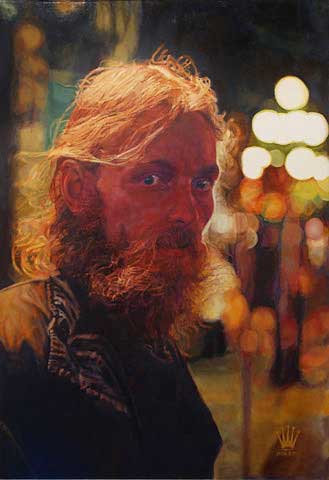-

Robert Standish
Street / Lights
Robert Standish: Street / Lights
October 31—December 6, 2008
On view at Carrie Secrist Gallery until December 6, is “Street / Lights” an exhibition of oil paintings by Robert Standish. Working in a more traditional mode than other contemporary painters, Standish turns his attention to the issues that we tend to avoid easily: homelessness and prostitution.
It seems to be increasingly difficult to paint photorealistically. Virtuosity for its own sake usually is the object for many artists and is usually complicated by overly-didactic, blatantly populist, or just plain boring, subject matter. Plus the glut of photorealistic and social-realism work coming from China makes it even more difficult. And then there’s photography. . . It is therefore all the more notable that Standish is able to make work in a realist mode that avoids the many pitfalls presented.
Gastown Finn (Rolex), (2000-2006), is a large oil on canvas near to the entrance of the gallery. Depicting what seems to be a homeless man at night, Standish captures his steady gaze at the viewer with city lights glowing like little balls in the background. Across from the figure at the lower right corner of the canvas is the trademarked Rolex crown. While the catalog for the exhibition sources this symbol to Basquiat, that seems to me to be only coincidence, maybe an intended tribute. More pertinently, the crown of the Rolex brand is positioned as the height of luxury and wealth. Indeed, everytime I ride the CTA train, ads for a certain jewelry store confront me with a haughty model (who may or may not have eyes, the lighting and his hawkish features are so severe) and a single large word, STATUS, as he flashes his watch. Standish’s combination of the Rolex trademark and the disheveled impoverished man recalled that CTA ad immediately. Standish uses the trademarks to essentially brand these images of inequality.
This becomes more clear in his other figurative paintings, most of which on view at Secrist Gallery feature prostitutes. The work Nike Prostitute (2005), shows the back of woman walking paired with Nike’s trademark swoosh, again found in the lower right corner where the artist’s signature traditionally is (and actually is in some works). Very few of us can see that logo without thinking “Just Do It,” Nike’s slogan that accompanies the recognizable shape. Besides creating a bad sex pun, Standish’s evocation of that particular symbol recalls the numerous scandals that Nike has been embroiled in all over the globe for various labor abuses. Another scene of inequality, this time brought to you by Nike.
The back room of Secrist contains Standish’s paintings of city lights. They are out-of-focus and so become abstractions, and quite pleasing ones at that. These images of lights focus on the out-of-focus so that one gets the distinct feeling that one is looking away or avoiding something. The bright city lights promise distraction at night, something we can look at instead of the beggars and prostitutes. There seems to be an implicit critique in these works, as if Standish is saying, Well if looking at the poor and prostitutes are too much, here’s a picture where you are ignoring them. Just like in real life. They’re also much more salable, as the dots on the title guide confirmed.
Ultimately Standish’s work seems much more akin to Manet than the work of a social realist painter. And it is that affinity, deceptively simply updated for the 21st century, that makes Standish’s photorealist mode work.
–By Abraham Ritchie, Art Slant Chicago, 1 December 2008